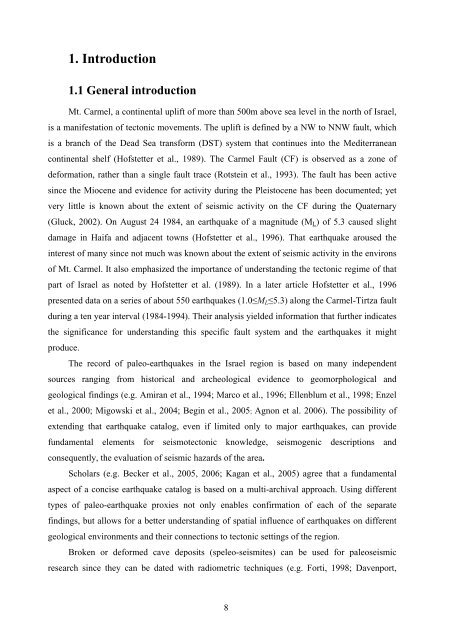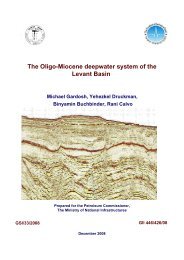tivity on the carmel faul
tivity on the carmel faul
tivity on the carmel faul
You also want an ePaper? Increase the reach of your titles
YUMPU automatically turns print PDFs into web optimized ePapers that Google loves.
1. Introducti<strong>on</strong><br />
1.1 General introducti<strong>on</strong><br />
Mt. Carmel, a c<strong>on</strong>tinental uplift of more than 500m above sea level in <strong>the</strong> north of Israel,<br />
is a manifestati<strong>on</strong> of tect<strong>on</strong>ic movements. The uplift is defined by a NW to NNW <strong>faul</strong>t, which<br />
is a branch of <strong>the</strong> Dead Sea transform (DST) system that c<strong>on</strong>tinues into <strong>the</strong> Mediterranean<br />
c<strong>on</strong>tinental shelf (Hofstetter et al., 1989). The Carmel Fault (CF) is observed as a z<strong>on</strong>e of<br />
deformati<strong>on</strong>, ra<strong>the</strong>r than a single <strong>faul</strong>t trace (Rotstein et al., 1993). The <strong>faul</strong>t has been active<br />
since <strong>the</strong> Miocene and evidence for ac<str<strong>on</strong>g>tivity</str<strong>on</strong>g> during <strong>the</strong> Pleistocene has been documented; yet<br />
very little is known about <strong>the</strong> extent of seismic ac<str<strong>on</strong>g>tivity</str<strong>on</strong>g> <strong>on</strong> <strong>the</strong> CF during <strong>the</strong> Quaternary<br />
(Gluck, 2002). On August 24 1984, an earthquake of a magnitude (M L ) of 5.3 caused slight<br />
damage in Haifa and adjacent towns (Hofstetter et al., 1996). That earthquake aroused <strong>the</strong><br />
interest of many since not much was known about <strong>the</strong> extent of seismic ac<str<strong>on</strong>g>tivity</str<strong>on</strong>g> in <strong>the</strong> envir<strong>on</strong>s<br />
of Mt. Carmel. It also emphasized <strong>the</strong> importance of understanding <strong>the</strong> tect<strong>on</strong>ic regime of that<br />
part of Israel as noted by Hofstetter et al. (1989). In a later article Hofstetter et al., 1996<br />
presented data <strong>on</strong> a series of about 550 earthquakes (1.0≤M L ≤5.3) al<strong>on</strong>g <strong>the</strong> Carmel-Tirtza <strong>faul</strong>t<br />
during a ten year interval (1984-1994). Their analysis yielded informati<strong>on</strong> that fur<strong>the</strong>r indicates<br />
<strong>the</strong> significance for understanding this specific <strong>faul</strong>t system and <strong>the</strong> earthquakes it might<br />
produce.<br />
The record of paleo-earthquakes in <strong>the</strong> Israel regi<strong>on</strong> is based <strong>on</strong> many independent<br />
sources ranging from historical and archeological evidence to geomorphological and<br />
geological findings (e.g. Amiran et al., 1994; Marco et al., 1996; Ellenblum et al., 1998; Enzel<br />
et al., 2000; Migowski et al., 2004; Begin et al., 2005; Agn<strong>on</strong> et al. 2006). The possibility of<br />
extending that earthquake catalog, even if limited <strong>on</strong>ly to major earthquakes, can provide<br />
fundamental elements for seismotect<strong>on</strong>ic knowledge, seismogenic descripti<strong>on</strong>s and<br />
c<strong>on</strong>sequently, <strong>the</strong> evaluati<strong>on</strong> of seismic hazards of <strong>the</strong> area.<br />
Scholars (e.g. Becker et al., 2005, 2006; Kagan et al., 2005) agree that a fundamental<br />
aspect of a c<strong>on</strong>cise earthquake catalog is based <strong>on</strong> a multi-archival approach. Using different<br />
types of paleo-earthquake proxies not <strong>on</strong>ly enables c<strong>on</strong>firmati<strong>on</strong> of each of <strong>the</strong> separate<br />
findings, but allows for a better understanding of spatial influence of earthquakes <strong>on</strong> different<br />
geological envir<strong>on</strong>ments and <strong>the</strong>ir c<strong>on</strong>necti<strong>on</strong>s to tect<strong>on</strong>ic settings of <strong>the</strong> regi<strong>on</strong>.<br />
Broken or deformed cave deposits (speleo-seismites) can be used for paleoseismic<br />
research since <strong>the</strong>y can be dated with radiometric techniques (e.g. Forti, 1998; Davenport,<br />
8

















